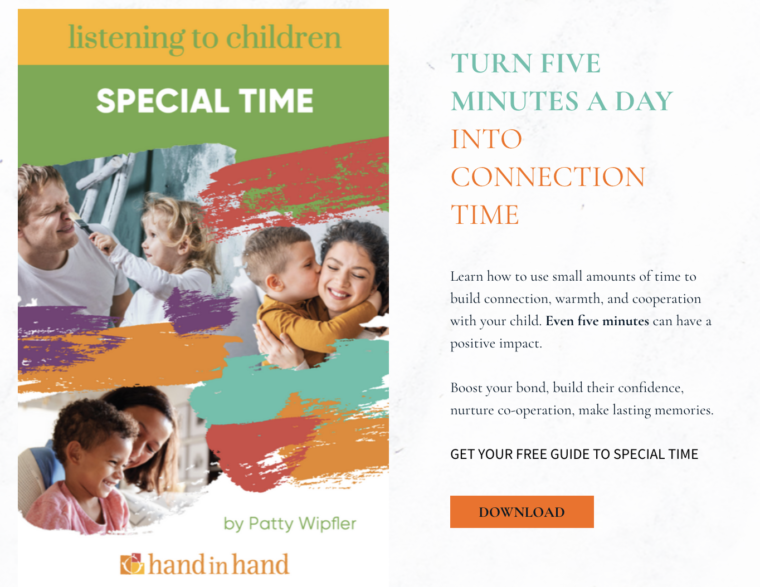Tantrums feel hard enough to handle when you're at home without an audience. But tantrums in public with a slew of on-lookers, their glances loaded with judgment, can be enough to send any parent into an emotional tailspin of his or her own! I hope someday soon our world will look more kindly on parents, children, and the sometimes messy emotions that spill out at the most inconvenient times and places for us. In the meantime, here are five ways to help prevent tantrums in public and enjoy your outing with your children.
1. Take time to connect BEFORE you leave the house
 Parents have full and busy lives. It's easy to become stressed and overwhelmed with the tasks for our day and easier still to want to move at lightning speed to “just get it done.” Yet, the more we try to push through our day, while dragging our kiddos along, the more we set the stage for tantrums in public.
Parents have full and busy lives. It's easy to become stressed and overwhelmed with the tasks for our day and easier still to want to move at lightning speed to “just get it done.” Yet, the more we try to push through our day, while dragging our kiddos along, the more we set the stage for tantrums in public.
Rushing from one item on your To-Do list to the next is often the very thing that triggers feelings of an emotional emergency for your child. One of the best things you can do to counter these feelings is to spend 5 to 10 minutes before leaving the house slowing down the action and tuning in with your child.
One way to do this is by having Special Time. During Special Time you designate an amount of time that you will play whatever your child wants and offer her your full attention. This fills your child with the feeling of being connected with you. Just as you wouldn't take your child out with an empty stomach (that's really asking for trouble!), don't take your child out when her emotional connection cup is empty.
Even something like a quick game of chase or a special story read with your loving attention lets your child know she is important to you in the midst of all the daily tasks. These gestures of love and affection will help sustain your child while you are out and about and can go a long way toward preventing tantrums in public.
2. Once connected, stay connected
Connection is easily broken. At home, a couple of minutes on the phone or a quick trip to the bathroom can send a happily playing child into a big upset or off-track behavior. This happens even more easily when we’re in public, where we turn our attention toward many other things like driving, shopping, fulfilling our to-do list, checking our phones or even just enjoying time connecting with other adults.
When your children sense they have faded from your emotional radar it can spark an emotional emergency for them. Some children may come running to you to check in, some will cling or want to be held, and others will move into literally screaming for your attention by having tantrums in public. All are signaling the same thing: “Help! I've lost touch with you and I need to feel your presence again.”
Staying connected to your children away from home means offering eye contact, touch, and other bits of focused attention in the midst of your activities.
It seems simple, but think about how easy it is to not even look at your child while grocery shopping, especially if they are content and quiet for the moment!
You sense them with your peripheral vision and know all is well, but this is not the same as direct eye contact and a smile that can convey messages like, “I see you. I'm watching out for you. I'm glad you're here,” to your child.
Another way to help keep your child engaged and connected to the activities around them is by offering simple choices like, “Red apples or green?” while at the grocery store or “Coloring book or look at the menu with me?” while dining out. These simple choices help children feel involved and included, and when children feel a part of things they are less likely to go into an emotional emergency.
3. Use play to diffuse tension and prevent tantrums in public
Contrary to some popular opinions, it is best not to ignore an upset that is starting to surface. Step in right away! Finding ways to encourage laughter will help your child relieve some tension and feel more connected with you. The more connected your child feels the more cooperative she is likely to be.
When the inevitable “No” must be said, as often happens when shopping, stop for a moment and get down to your child's level.
Make eye contact and offer affection.
A playful, “Oh! I know you want that cereal!” snuggle that gets your child laughing shifts the attention away from “No” and back to the connection you share with your child. A child who is able to fully feel your love and care is way less likely to throw tantrums in public.
The mom in this story is quick to spot some tension brewing at the grocery store with her two sons. She steps in quickly, and playfully, to turn the tension into laughter.
Tension can also pop up in the car where it is hard to connect from the front seat to the back. When I sense tension in the back seat I will now reach back and ask my daughter, “Can we hold hands?” More often than not she puts her shoe in my hand instead! I squeal and pull my hand back saying, “Eww! Eww!” while she laughs and laughs.
I try again and again each time letting her know I am really hoping for her hand. And each time she tricks me by putting her shoe in my hand.
This keeps her giggling as she enjoys the more powerful role. Bit by bit the tension melts away with her giggles, and we arrive at our destination in happier spirits.
Read Next? Ways to stop your toddler running away
4. Find support for yourself
 If you're already stressed to the max, just the thought of trying to think up playful responses while out and about can be enough to send you into overload. The spectre of tantrums in public, enough to keep you at home!
If you're already stressed to the max, just the thought of trying to think up playful responses while out and about can be enough to send you into overload. The spectre of tantrums in public, enough to keep you at home!
The truth is, we all could use more support, especially around the emotional aspects of parenting. Finding this support can be tricky, but it's not impossible. It could be talking to a friend who listens well (but doesn’t give much advice) about how hard it is to go out with your child or the looks you get from strangers when your child has a meltdown in public. It could be joining a supportive group of parents online.
Finding support can also mean asking a friend to help. This mom asked a friend for support so she could listen to her son tantrum at the grocery store.
The more you are able to release the tension you carry, the more you will be able to respond warmly and creatively in the moment with your child.
Get your parenting questions answered 24/7 in Hand in Hand's Parent Club Community.
5. Listen to your child's feelings at home
Feelings happen. We can learn to stay better connected to our children so their emergency signal doesn't go off, and we can learn to shift tension into laughter when we see it brewing, but our children are still going to have times when they need to have a big cry or tantrum.
The more we ask our child to “keep it together” at home and in public, the more the tension bottles up inside them. The more we can find the time and space within ourselves to listen to our child's feelings of upset at home, the fewer bottled up feelings they’ll carry along with them on every excursion. Over time, they can become far less easily triggered into tantrums in public.
So the next time your child “loses it” at home, practice staying close and supportive while your child tantrums the frustration away. These moments, which are some of the hardest in parenting, are what strengthen our parent-child bond.
And when that big upset does occur when you are out with your child? Here are some tips on helping children with tantrums in public.
From the Hand in Hand Toolbox:

- For your free copy of Tantrums and Indignation by Patty Wipfler, click here.
- Find out how Hand in Hand's Five Tools could transform your parenting
- Read chapter 1 of Listen: Five Simple Tools to Meet Your Everyday Parenting Challenges



